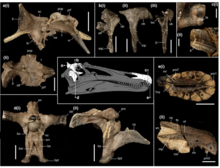Ceratosuchops
| Ceratosuchops Temporal range: Barremian,
| |
|---|---|

| |
| Holotype skull fragments | |
| Scientific classification | |
| Kingdom: | Animalia |
| Phylum: | Chordata |
| Clade: | Dinosauria |
| Clade: | Saurischia |
| Clade: | Theropoda |
| Family: | †Spinosauridae |
| Clade: | †Ceratosuchopsini |
| Genus: | †Ceratosuchops Barker et al., 2021 |
| Type species | |
| †Ceratosuchops inferodios Barker et al., 2021
| |
Ceratosuchops (meaning "horned crocodile face") is a genus of spinosaurid from the Early Cretaceous (Barremian) of Britain.
Discovery and naming[]

In 2021, the type species C. inferodios was named and described by a team of paleontologists including Chris Barker, Darren Naish, David Hone and others. The specific name means "hell heron", in reference to the ecology presumed by the research team.
The holotype remains of this taxon consist of IWCMS 2014.95.5 (premaxillary bodies), IWCMS 2021.30 (a posterior premaxilla fragment) and IWCMS 2014.95.1-3 (a nearly complete braincase), all of which were recovered from rocks in Chilton Chine of the Wessex Formation and stored at Dinosaur Isle museum. Referred remains include a single right postorbital (IWCMS 2014.95.4).
Description[]

Ceratosuchops is estimated to measure 8.5 m (27 ft) in length based on the skeletal reconstruction in the describing paper by Dan Folkes, 2021.[1]
Phylogeny[]
The authors recovered Ceratosuchops as a member of the newly erected clade, Ceratosuchopsini, closely related to Suchomimus and the coeval Riparovenator.[1][2]
Paleoenvironment[]
Ceratosuchops lived in a dry mediterranean habitat in the Wessex Formation, where rivers were home to riparian zones.[3][4] Like most spinosaurs, it would have fed on available small to medium-sized aquatic and terrestrial prey in these areas.[5][6][7]
References[]
- ^ a b Barker, C.T.; Hone, D.; Naish, D.; Cau, A.; Lockwood, J.; Foster, B.; Clarkin, C.; Schneider, P.; Gostling, N. (2021). "New spinosaurids from the Wessex Formation (Early Cretaceous, UK) and the European origins of Spinosauridae". Scientific Reports. 11 (1): 19340. doi:10.1038/s41598-021-97870-8. PMC 8481559. PMID 34588472.
- ^ Naish, Darren (September 29, 2021). "Two New Spinosaurid Dinosaurs from the English Cretaceous". Tetrapod Zoology. Archived from the original on 2021-09-29.
- ^ Penn, Simon J.; Sweetman, Steven C.; Martill, David M.; Coram, Robert A. (2020). "The Wessex Formation (Wealden Group, Lower Cretaceous) of Swanage Bay, southern England". Proceedings of the Geologists' Association. 131 (6): 679–698. doi:10.1016/j.pgeola.2020.07.005. S2CID 228820795.
- ^ Radley, Jonathan D.; Allen, Percival (2012). "The southern English Wealden (Non-marine Lower Cretaceous): Overview of palaeoenvironments and palaeoecology". Proceedings of the Geologists' Association. 123 (2): 382–385. doi:10.1016/j.pgeola.2011.12.005.
- ^ Hendrickx, C.; Mateus, O.; Buffetaut, E. (2016). "Morphofunctional Analysis of the Quadrate of Spinosauridae (Dinosauria: Theropoda) and the Presence of Spinosaurus and a Second Spinosaurine Taxon in the Cenomanian of North Africa". PLOS ONE. 11 (1): e0144695. Bibcode:2016PLoSO..1144695H. doi:10.1371/journal.pone.0144695. PMC 4703214. PMID 26734729.
- ^ "'Hell heron' dinosaur is new species found on Isle of Wight".
- ^ "'Horned crocodile-faced hell heron' is one of two new Isle of Wight dinosaur discoveries". 29 September 2021.
- Spinosaurids
- Monotypic dinosaur genera
- Barremian life
- Early Cretaceous dinosaurs of Europe
- Cretaceous England
- Fossils of England
- Fossil taxa described in 2021
- Theropod stubs
- Taxa named by Darren Naish













